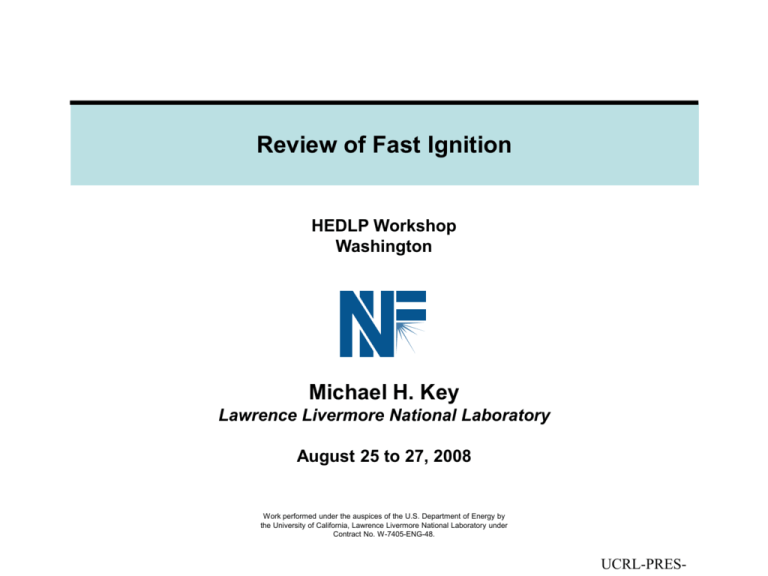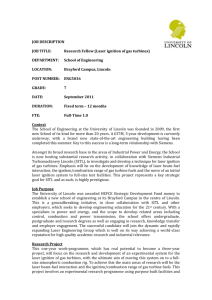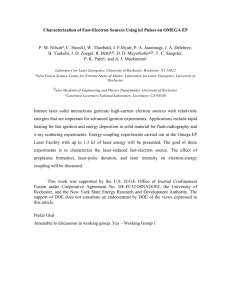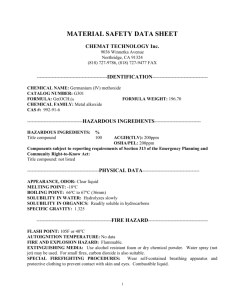Review of Fast Ignition
advertisement

Review of Fast Ignition HEDLP Workshop Washington Michael H. Key Lawrence Livermore National Laboratory August 25 to 27, 2008 Work performed under the auspices of the U.S. Department of Energy by the University of California, Lawrence Livermore National Laboratory under Contract No. W-7405-ENG-48. UCRL-PRES- Acknowledgements K. Akli2, F. Beg5, R. Betti6, D. S. Clark1, S. N. Chen5, R.R. Freeman2,3 S Hansen1,S.P. Hatchett1, D. Hey2, J.A. King2, A. J. Kemp1, B.F. Lasinski1 B.Langdon1,T. Ma5, A.J. MacKinnon1, D. Meyerhofer10, P.K. Patel1, J. Pasley5 R.B. Stephens4, C. Stoeckl6, M. Foord1, M. Tabak1, W. Theobald6, M. Storm6 R.P.J. Town1, S.C. Wilks1, L. VanWoerkom3, M.S. Wei5, R. Weber3, B. Zhang2 1Lawrence 2Department Livermore National Laboratory, Livermore, CA 94550, USA of Applied Sciences, University of California Davis, CA 95616, USA 3Ohio State University, Columbus Ohio, 43210 USA 4General 5 Atomics, San Diego, CA, 92186, USA University of California, San Diego, San Diego, CA, 92186, USA 6Laboratory of Laser Energetics, University of Rochester, NY, USA Special thanks for advice and information : Mike Dunne, Wolfgang Theobald, Javier Honrubia, Hiroshi Azechi, Riccardo Betti Outline •Concept of FI •Ignition requirements and gain •Cone coupled electron FI •Channel electron FI •Proton and mid Z ion ignition •Major integrated experiments •Summary Fast Ignition is ICF with separate compression and ignition drivers Hole boring for laser to penetrate close Light to pressure densebores fuel hole in coronal plasma Laser Hole boring Ignition 10010 kJ,kJ, 2010psps • Laser hole boring and heating by laser generated electrons was the first FI concept • 1MeV electron range matched to ignition hot spot 1 MeV electrons heat DT fuel to 10 keV 300 g/cc Pre-compressed fuel 300 gcm-3 • Absorption of intense laser light produces forward directed electrons • e-beam temperature = ponderomotive potential Fast ignition M Tabak, S Wilks et al. Phys. Plasmas1,1626, (1994) Several modeling studies have confirmed that FI offers high gain at low driver energy 2D simulations of ignition and burn by 15kJ, 2MeV, 20µm, 15ps e-beam Gain e.g. R. Betti, A.A. Solodov, J.A. Delettrez, C. Zhou, Phys. Plasmas 13, 100703 (2006) Maximum FI gain at 300g/cc 200 150 200kJ PW 100kJ PW 100 50 0 0.5 1 1.5 2 Driver Energy (MJ) >100x gain with 500kJ driver is attractive for IFE 2.5 The cone coupled FI concept provides a clear path for the laser with the electron source close to the ignition spot <rR>DT=2.2 g cm-2 Laser Au cone 100mm S Hatchett et al. - 30th Anom. Abs. Conf. Maryland, May 2000 Radiation - hydro simulations are well developed for ICF and allow hydro--design optimization for FI The first cone coupled fast ignition experiment at the Gekko laser in Japan gave very encouraging results Gekko “Cone” implosion Implosion beams • 1000x increased DD neutrons R Kodama et.al. Nature 412(2001)798 and 418(2002)933. 30% coupling 0.5 PW laser 15% coupling • 0.5PW ignitor beam gave ≈ 20% energy coupling to imploded CD SP Laser 50 mm Outstanding question for FI is What coupling is the efficiency at ignition scale ? The energy required in the ignition hot spot and the optimum electron energy are well established S. Atzeni, Phys. Plas. 8, 3316 (1999) M Tabak et al Fus. Sci. Tech. (2006) Optimal ignition criteria: T = 12keV, rR = 0.6 g/cm2 Eign Fast Ignition region r E 2r DT z t 1.85 r 140 kJ 3 100 g /cm For r = 300 g/cm3 assembly we need to deliver to the fuel: E = 18kJ in <2MeV> electrons P = 0.9 PW => t = 20ps I = 6.8x1019 W/cm2 => r = 20mm • Coupling efficiency depends on: – laser conversion to electrons – energy spectrum of electrons – collimation of electron transport – cone tip to dense plasma separation Maximizing coupling efficiency at full scale is the overall design challenge in FI Hybrid PIC coupled to hydro-modeling predicts the electron transport and electron coupling efficiency to the ignition spot 300kJ drive 1D fuel With B field 43 kJ No B field 115 kJ A A Solodov et al. ( preprint of publication ) The focusing effect of azimuthal B from dB/dt= curl(E) increases transport efficiency by factor >2.5x Increased source divergence and distance to fuel increase the ignition energy - reduction by B field collimation is robust Coupling of electron source to ignition hot spot can be > 50% efficient for typical beam divergence and transport distance J Honrubia and J Meyer ter Vehn EPS Plasma Conf 2008 Cold target experiments at <1PW show typically 40o cone angle of electron transport 600 500 Spot diameter, µm 180 mm RAL 100J,0.8 ps 40ocone 400 LULI 20J,0.5 ps 300 200 2500 RAL data 5000 7500 10000 12500 0905xray03 Cone angle 40o Min radius 37 mm 100 0 0 100 200 300 400 thickness, µm AlAlthickness micron R Stephens et al. Phys Rev E,69, 066414, ( 2004) 500 Al 20 mm Cu 20mm New warm plasma experiments are planned using long pulse beams to prepare plasma ( A Mackinnon talk to follow ) Recent 2D PIC modeling predicts a cooler two temperature electron source and 30 to 35% conversion to electrons Chrisman , Sentoku and Kemp PoP, 2008 Cool component is from light pressure steepened interface and hot component from critical density shelf A Kemp et al. PRL 2008 H Sakagami et al. FIW 2008 Possibility of optimizing Thot and absorption efficiency using low density foam layer to tailor the density profile Coupling efficiency and effective Thot inferred from Ohmic potential limited transport in cone- wire targets at Vulcan PW 256 XUV 1mm 10 mm 500 µm •Sensitivity to pre-pulse and cone wall thickness measured at Titan M Key et al Proc IFSA 2005 and J King et al PoP ( submitted) Electron source studies with the Titan laser also point to eletron temperature < ponderomotive potential QuickTime™ and a TIFF (LZW) decompressor are needed to see this picture. •Hybrid PIC modeling of K data gives conversion efficiency •Thot analysis using focal spot power fraction v intensity • Bremsstrahlung data consistent with CSK PIC modeling More in talk by R Stephens to follow Point designs require simultaneous optimizing of many aspects of the hot electron generation, electron transport and hydrodynamics Near 1-D isochoric implosions to minimize low density high temperature hotspot at center Minimize high-Z cone material in fuel Cone tip survival clear path for laser Compressed fuel Minimize transport distance from cone to fuel Cone The cone tip hydro problem is very challenging at full scale because at fixed separation of tip and ignition spot the pressure is much higher relative to smaller scale e.g. Gekko experiment 1D target designs for direct-drive FI use massive wetted foam shells insensitive to fluid instability 25 kJ Omega Scale 40 mm 90 mm 298 mm rR3g/cm2 rR1.9g/cm2 rR0.7g/cm2 <r>300-500g/cm3 R. Betti and C. Zhou, Phys. Plasmas 12, 110702 (2005) CH implosions with low adiabat were tested on OMEGA EL20kJ P25-34atm 1.3 V2•107cm/s D-3He fusion proton energy loss measured the high rR D2 or D3He a.u. Secondary proton spectrum measured predicted 0 5 10 15 Energy (MeV) • Peak rR is 0.26g/cm,2 the highest rR to date on OMEGA • Empty shells would achieve rR0.7g/cm2 C. Zhou, W. Theobald, R. Betti, P.B. Radha, V. Smalyuk, C.K.Li et al, PRL2008 NIF can drive full scale FI targets using 650kJ indirect drive and ID designs for CD and DT are being developed Be DT Be Trad (eV) 1235 µm 1139 µm 1087 µm 1070 µm 870 µm density (g/cm3) Be (0.9%) Cu 10-6g/cm3 DT time (ns) radius Small hotspot rr ~ 2 g/cm2 •Peak power: 70TW Hydro tests with Be/CD targets on NIF will begin in 2010 •Pulse length: 32 ns •Max blue energy: 650kJ •Contrast ratio: 35:1 More in talk by D Clark to follow •Peak Trad = 210eV Destruction of cone tip by hydro jet and entrainment of ablated high z cone in to fuel are important design issues QuickTime™ and a TIFF (Uncompressed) decompressor are needed to see this picture. Stoeckl C. et al., Phys. Plasmas 14 112702 (2007) CH tamped cone Nagatomo et al PoP 2007 Direct ignition by the main PW pulse ( super-penetration ) is an option being considered thro’ modeling and experiment • 1D hydro- modeling has established the density profile Nc/4 • PIC modeling has shown the main pulse penetrating beyond critical density with relativistic self focusing Y Sentoku et al . Fus Sci Tech,49,278,(2006) • Excessive Thot is a problem which could be mitigated with a shorter wavelength Nc 1gcm-3 1mm •Nc to >1 gcm-3 requires >200mm penetration -not modeled •Shorter wavelength would allow penetration closer to the ignition region There is however no self consistent point design for ignition The original channeling and hole boring scheme using a prepulse is being studied in the Omega EP project • 2D PIC modeling has shown channel production up to critical density in a plasma of full FI scale. 1019 Wcm-2 hole boring in 1 mm scale sub criticaL density plasma C Ren FIW (2006) • Lacks modeling to show channel extension by hole boring to bring the laser close enough to the ignition region (requires ~200 mm hole boring to few gcm-3) • The propagation of the main pulse in the channel has not been modeled • Shorter wavelength makes channel to higher density There is so far no point design for high gain Ion fast ignition by protons or carbon ions offers alternatives with some attractive features •Light pressure and BOA for C ions NEW J Fernandez et al. Proc IFSA 2007 and talk to follow •TNSA for protons M Key et al Fus Sci Tech 2006 J Honrubia EPS Plasma Conf 2008 A conceptual design for proton fast ignition illustrates the issues •Cone maintains vacuum region for proton plasma jet formation and protects surface of proton source foil Laser •Scattering limits thickness of cone tip and separation from fuel Laser 100kJ,3 ps 1020 Wcm-2 Proton heating 50kJ electrons 200mm kT=3 MeV •DT fuel at 500g/cc •60 mm ignition spot (same as electron ignition) Cu K image 20 kJ protons kT= 3 MeV XUV •Radially uniform proton plasma jet required for smallest focal spot PW laser •Proton source foil protects rear surface from pre-pulse -thickness limits conv. efficiency Requirements based on Ignition with protons : Atzeni et al .Nucl Fus 42,(2002) Modeling of focusing suggests that FI requirements can be met with open geometry ( cone enclosed study ongoing ) 10 mm Au,1mm H , Thot 3 MeV , 47% conversion to protons >3MeV 80% of energy at >3MeV can be delivered to 60 mm focal spot from an f/1 segment of a 300 mm radius spherical shell Hybrid PIC modeling by M Foord LLNL using LSP code Good electron to proton conversion efficiency with no depletion are predicted for thin Au targets with a hydride layer Proton conversion efficiency (%) Hydrides Thot=880keV 5 mm Au + 1000Ѓ ZH B H Z C 40 Electron to Proton eff. n H 35% ErH3 30% 30 CH 4 20 CH 2 CH 10 0 More in talk by M Foord to follow H LiH CH n MgH CaH CsH ErH 2 ZH 2 3 UH 3 n Hybrid PIC modeling by M Foord LLNL using LSP code Definitive integrated Fast Ignition experiments will be performed with facilities soon to come on line Omega EP PETAL LIL FIREX I NIF ARC Quad NIF FI high gain HIPER Schedule d Fall 2008 2009-2010 2009-2010 2011 ? ? ? Long pulse(kJ) 25 60 10 800 800 200 50 Short pulse(kJ) 2.6 / beam 5.2 max 3.5 10 10 60 1w? 100 2w? 50 Scaled hydro rR 0.2 ? 0.15 2 2 to 3 2 to 3 2 to 3 Density g/cc 300 ? 150 300-500 300-500 300-500 300-500 Hole boring Y ? Y Cone guided Y Y Y Y 5keV Y Near ignition High gain Firex II ? Y Y Y >100 >100 >100 More in talks by W Theobald and A MacKinnon to follow The high gain and low driver energy and possibility of two opposed narrow cones of laser beams are attractive for IFE Pure fusion and also fusion fission hybrids burning nuclear waste, are possible I-LIFT (Japan), Hiper (Europe), LIFE (LLNL ) are examples of study of FI power plant concepts HED Science and IFE relevance of Fast Ignition ( FI ) •Fast ignition requires extremely high energy density 10keV, 300 to 500 g/cc in (40 mm)3 •FI uses ignition methods (laser generated electron and ion beams) that can heat any material isochorically (using inertial confinement) to multi- keV temperature . •Thermonuclear burn creates still higher energy density FI cone targets will allow HED science using precise exposure of matter to extreme energy density and radiation and particle fluxes •The underlying science of FI is that of more general HED science •FI is an outstanding example of an application of HED science •FI has significant advantages for an IFE power plant ( lower driver energy ,higher gain, better laser beam geometry ) •The potential and prospects of FI have led to major investments worldwide Scientific challenges and opportunities •Validated modeling and control of the source characteristics of laser generated relativistic electrons ( <E>=<2MeV>, >30% conversion ) at FI relevant laser parameters ( >1020 Wcm-2 , ~100kJ, <20 ps ) •Validated modeling and control of transport of electron energy to ignition spot - (magnetic collimation > 50% electron coupling efficiency ) •Advanced hydrodynamic design meeting multiple constraints for FI point designs e.g. optimizing implosion around a cone tip - designing targets for IFE with laser beams restricted to two cones •Developing >10% efficient ion acceleration concepts to meet FI requirements ( e.g TNSA , light pressure and BOA concepts ) •Validated modeling and control of the focusing of laser generated ion beams to meet FI requirements ( 40 micron focal spot ) •Novel HED science using thermonuclear burn Anticipated technical advances and opportunities •Better integrated codes ( PIC, hybrid PIC, rad-hydro)benchmarked by experiments - improved target point designs •Next generation large scale integrated experiments using point designs ( Omega EP , FirexI , Petal and NIF ARC Quad ) •High gain FI using adapted or new laser facilities (adapted NIF or LMJ, Firex II , Hiper ) •HED science applications of FI thermonuclear burn •IFE power plant concepts ( pure fusion and hybrid fission fusion ) •Laser technology for rep rated FI •Low cost high volume target fabrication and injection •IFE demo and IFE power production







